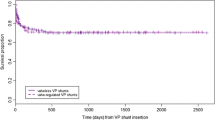Abstract
Background
Intra-ventricular haemorrhage (IVH) can occur spontaneously or during the surgical revision of ventricular cerebrospinal fluid (CSF) shunts.
Aim
The aim of the study was to report the safety and efficacy of an original method for treatment of IVH that may occur at the time of valve revision aimed at maintaining the function of previously implanted CSF shunts.
Patients and methods
We reviewed the medical records of six patients who experienced an IVH in the presence of a previously placed ventriculoperitoneal (VP) shunt. Five of the haemorrhages occurred during ventricular catheter replacement and the remaining one in a child given a VP shunt who sustained a spontaneous intra-cerebral haemorrhage. We inserted an external ventricular drainage without removing the original shunt. Urokinase was administered via the ventricular drain during several days until blood clearance in the CSF. Disappearance of the ventricular clots was checked by a cranial computerised tomography scan, while CSF shunt function was verified by the children’s evolution and/or by a reservoir tap.
Results
Follow-up evaluation of the six patients demonstrated that the existing VP shunts were functioning appropriately and that the treatment was safe.
Conclusions
Patients with IVH complicating ventricular catheter replacement and patients with spontaneous bleeding who harbour a VP shunt can be treated by intra-ventricular urokinase to avoid the removal of the initial shunt. The technique has proven to be safe and utilises the ventricular drain placed for the acute management of the IVH. Shunt replacement will always be possible in case of failure of the technique we are reporting.



Similar content being viewed by others
References
Brownlee RD, Dold ONR, Myles ST (1995) Intraventricular hemorrhage complicating ventricular catheter revision: incidence and effect on shunt survival. Pediatr Neurosurg 22:315–320
Dedrick SC, Ramirez-Rico J (2004) Potency and stability of frozen urokinase solutions in syringes. Am J Health Syst Pharm 61:1586–1589
Haines SJ, Lapointe M (1999) Fibrinolytic agents in the management of posthemorrhagic hydrocephalus in preterm infants: the evidence. Child’s Nerv Syst 15:226–234
Hudgins RJ, Boydston WR, Hudgings PA, Adler SR (1994) Treatment of intraventricular hemorrhage in the premature infant with urokinase. Pediatr Neurosurg 20:190–197
Hudgings RJ, Boydston WR, Gilreath CL (1996) Urokinase in the treatment of shunt malfunctions caused by thrombus. Pediatr Neurosurg 25:315–320
Hudgings RJ, Boydston WR, Hudgins PA, Adler SM, Gilreath CL (1997) Intrathecal urokinase as a treatment for intraventricular hemorrhage in the preterm infant. Pediatr Neurosurg 26:281–287
Hudgings RJ, Boydston WR (1998) Shunt revision by coagulation with retention of the ventricular catheter. Pediatr Neurosurg 29:57–59
Luciano R, Velardi F, Romagnoli C, Papacci P, De Stefano V, Tortorolo G (1997) Failure of fibrinolytic endoventricular treatment to prevent neonatal post-haemorrhagic hydrocephalus. Child’s Nerv Syst 13:73–76
Martínez-Lage JF, Lopez F, Poza M, Hernández M (1998) Prevention of intraventricular hemorrhage during CSF shunt revisions by means of a flexible coagulating electrode. A preliminary report. Child’s Nerv Syst 14:203–206
Martínez-Lage JF, Almagro MJ, Sanchez del Rincón I, Pérez-Espejo MA, Piqueras C, Alfaro R, de San R, Pedro J (2007) Management of neonatal hydrocephalus: feasibility of use and safety of two programmable (Sophy and Polaris) valves. Child’s Nerv Syst 24:549–556
Pang D, Sclabassi RJ, Horton JA (1986) Lysis of intraventricular clot with urokinase in a canine model: part 1. Canine intraventricular clot cast model. Neurosurgery 19:540–546
Pang D, Sclabassi RJ, Horton JA (1986) Lysis of intraventricular clot with urokinase in a canine model: part 2. In vivo safety study of intraventricular urokinase. Neurosurgery 19:547–552
Pang D, Sclabassi RJ, Horton JA (1986) Lysis of intraventricular clot with urokinase in a canine model: part 3. Effects of intraventricular urokinase on clot lysis and posthemorrhagic hydrocephalus. Neurosurgery 19:553–572
Pattisapu JV, Trumble ER, Taylor KR, Howard PD, Kovach TM (1999) Percutaneous endoscopic recanalization of the catheter: a new technique of proximal shunt revision. Neurosurgery 45:1361–1367
San Frutos MA, Fernández-Pavón A, Pérez-Higueras A, Roche MC, Ruza F (1986) Local urokinase for the treatment of ventriculitis complications. Acta Paediatr Scand 75:497–498
Steinbok P, Cochrane DD (1992) Removal of adherent ventricular catheter. Technical note. Pediatr Neurosurg 18:167–168
Whitfield PC, Guazzo ET, Pickard JD (1995) Safe removal of retained ventricular catheters using intraluminal choroid plexus coagulation. Technical note. J Neurosurg 83:1101–1102
Whitelaw A, Rivers RPA, Creighton L, Gaffney P (1992) Low dose intraventricular fibrinolytic treatment to prevent posthaemorrhagic hydrocephalus. Arch Dis Child 67:12–14
Whitelaw A (1993) Endogenous fibrinolysis in neonatal cerebrospinal fluid. Eur J Pediatr 152:928–930
Disclaimer
The authors have no financial or other interests in the products and devices utilised and mentioned in this work.
Author information
Authors and Affiliations
Corresponding author
Rights and permissions
About this article
Cite this article
Martínez-Lage, J.F., Almagro, MJ., Ruíz-Espejo, A. et al. Keeping CSF valve function with urokinase in children with intra-ventricular haemorrhage and CSF shunts. Childs Nerv Syst 25, 981–986 (2009). https://doi.org/10.1007/s00381-009-0889-4
Received:
Published:
Issue Date:
DOI: https://doi.org/10.1007/s00381-009-0889-4




